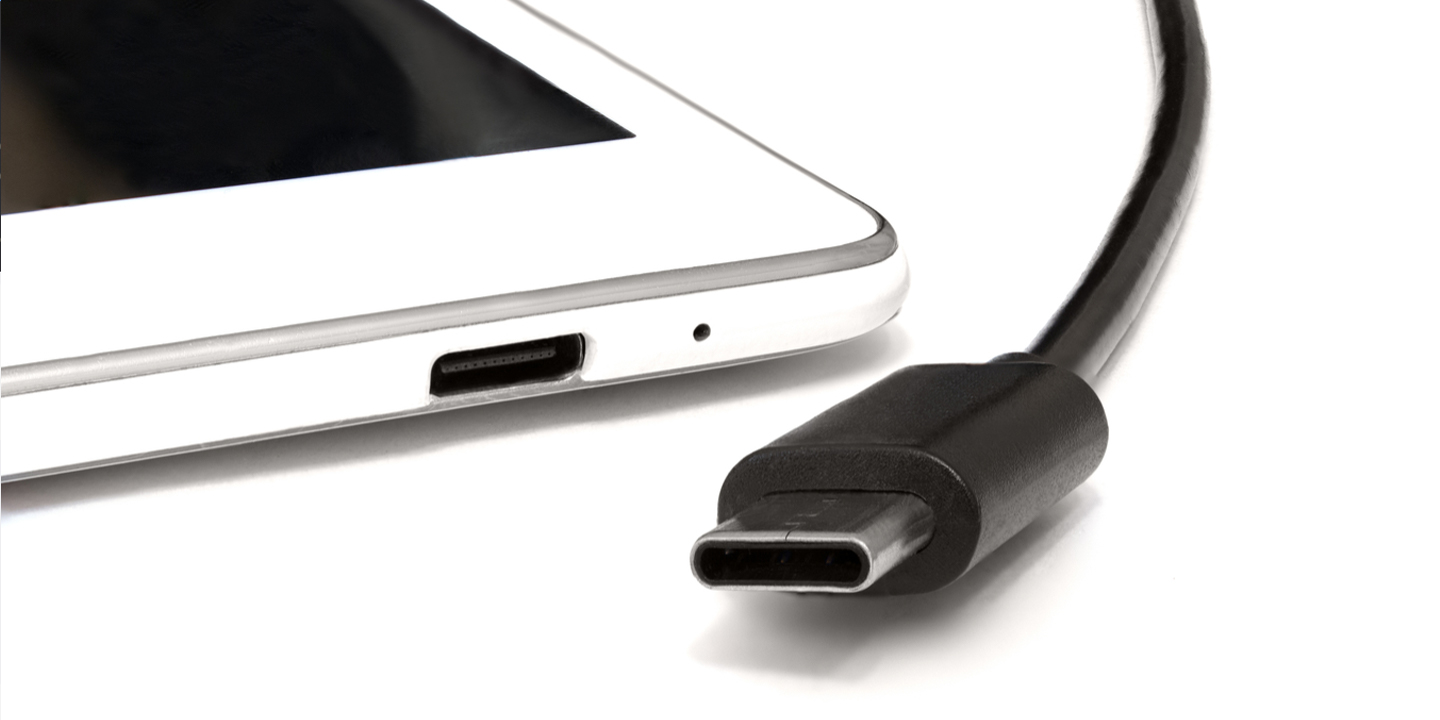
USB Type-C, also called USB-C, is the latest protocol for connection of devices and peripherals. It is an evolution from the commonly-used Universal Serial Bus (USB) and was developed to support higher transfer rates between smaller devices. Higher transfer rates allow elegant streaming of large amounts of data across multiple devices including video to smart phones, laptops, and other small form-factor devices in use by consumers today.
USB-C is distinguished by a new symmetrical port sporting a changed arrangement of dedicated pins. With symmetrical orientation at the connection point, the specification defines configuration pins to detect presence of peripherals along with current-carrying capability of the port. The developers came up with a scheme to enable backward compatibility with legacy USB so users may transition all devices seamlessly while the new standard populates.
USB power delivery (USB PD) is also available and evolving with USB-C protocol allowing up to 100W supported on a 20V rail. Configurations allow role swapping between hosts and peripherals supporting efficient power usage among devices while delivering higher rates of data. Power is always available through inventive charging protocols facilitated with alternate modes configured in the hardware.
Development of USB Type-C Evolves Speed and Function
The USB Implementers Forum continues to support evolution of the very popular universal serial bus. Devices entrenched in the digital landscape host communication via USB hardwired into existing connectors and their pinouts. Any changes to the protocol or the hardware supporting it could have a ripple effect affecting millions of users and the vendors that support the protocol.
Like with any USB cable, one’s first thought might be, when implementing a new USB, is how are the connector and adapter affected? A USB-C cable should be compatible with a lightning cable or other earlier USB types to ensure devices like a laptop do not end up powerless or dataless without a quick charge USB type-C cable to fill its battery pack.
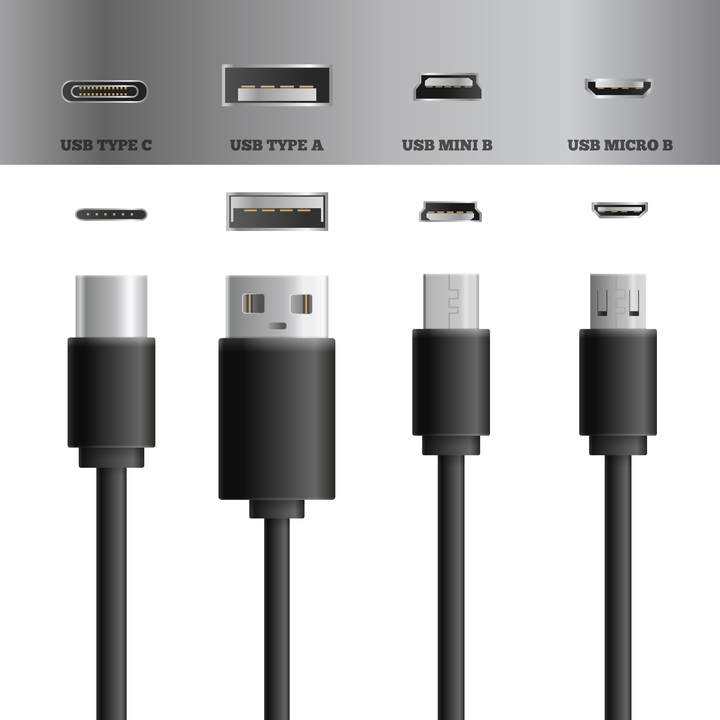 Side-by-side comparison of USB sockets and plugs
Side-by-side comparison of USB sockets and plugs
Supporting USB requires willingness to evolve along with inventions of faster data streams. Digital communication is a hungry beast transmitting increasing speeds across numerous devices becoming smaller in size. Supporting faster speeds on smaller products requires elegance across fewer connection points. Means for connecting older devices while supporting newer hardware is also necessary.
This led to development of the newest universal protocol USB-C. A new pinout supports faster transmission speeds while supporting alternate modes for backward-compatibility and for power delivery options. Not only that, but the new protocol is able to host alternate protocols such as DisplayPort, a USB-C port remaining nimble while keeping streaming functionality high. The developers modified the protocol to support future scalability, while maintaining backward-compatibility, without changing the pinout for future hardware.
Defining Characteristics of USB Type-C Symmetry
The new USB-C bus incorporates faster transmission buses along with older protocols. There are two SuperSpeed USB differential buses available for transmission speeds up to 20 Gbps. The port is backward-compatible supporting older universal protocols like USB type-A or USB type-B of Full-Speed at 12 Mbps and High-Speed at 480 Mbps. With dedicated pins, the older buses may operate in parallel with SuperSpeed transmission.
Configuration channels alert the host or peripherals of roles and modes while in operation. Modes include older universal protocol speeds and power delivery, in addition to hosting alternate protocol transmissions and analog audio transmission. The modes are entered by using dedicated configuration pins or reassigning pins as defined in the specification. Below are diagrams of the socket and plug interconnects. Note that the plug uses just one set of the older D+/D- pair to support symmetrical pinout at the connection point. Configuration resistors at the host communicate cable orientation to propagate the actual signals at the interface.
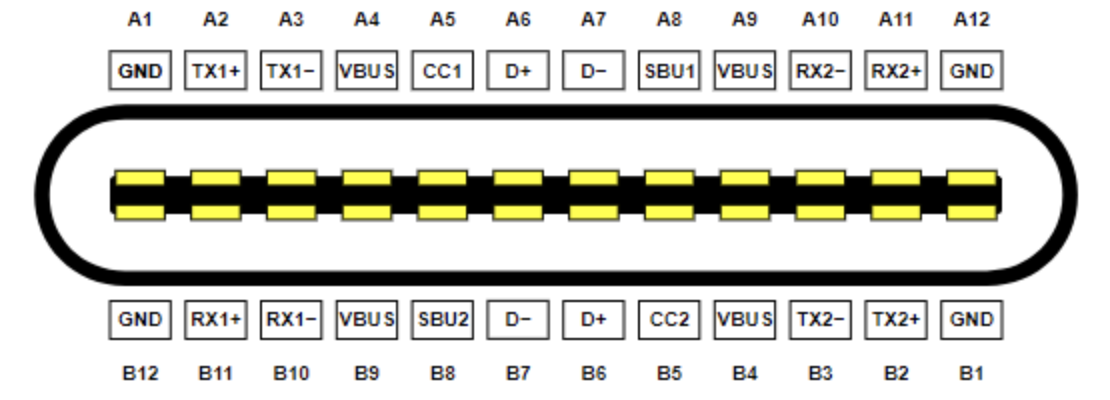 Symmetrical pinout distinguishes USB-C host socket
Symmetrical pinout distinguishes USB-C host socket
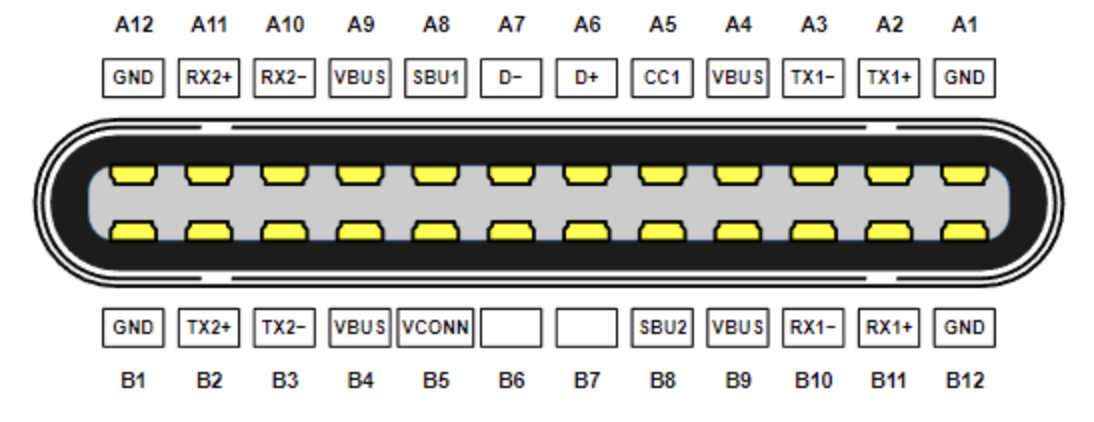 Symmetrical pinout configures D+/D- at the connector plug
Symmetrical pinout configures D+/D- at the connector plug
DisplayPort: A digital display interface developed by a consortium of PC and chip manufacturers and standardized by the Video Electronics Standards Association (VESA). The interface is primarily used to connect a video source to a display device such as a computer monitor, and it can also carry audio, USB, and other forms of data.
DFP: Downstream-facing port. A port on the host that sends data, providing VBUS for connected devices.
DRP: Dual-role-power. A power port that may either sink or source current, and may alternate between the two. Termination resistors are used to configure the port during operation of USB Type-C
GPIO: General Purpose Inputs and Outputs. These are interfaces to and from ICs for building in custom design features.
OSI: Open Systems Interconnection is a conceptual model that characterizes and standardizes the communication functions of a telecommunication or computing system without regard to its underlying internal structure and technology.
PHY: The physical layer of the OSI model and refers to the circuitry required to implement physical layer functions. A PHY connects a link layer device (often called MAC) to a physical medium such as an optical fiber or copper cable. A PHY device typically includes both Physical Coding Sublayer (PCS) and Physical Medium Dependent (PMD) layer functionality.
Thunderbolt: A brand name of hardware interface standard developed by Intel (in collaboration with Apple) that allows the connection of external peripherals to a computer. Thunderbolt 3 uses the same connector as USB Type-C. Thunderbolt combines PCI Express (PCIe) and DisplayPort (DP) into two serial signals, and additionally provides DC power, all in one cable. Up to six peripherals may be supported by one connector through various topologies.
UFP: Upstream-facing port. USB ports that receive data, sinking current from the host, VBUS.
USB: Universal Serial Bus. An industry standard that establishes specifications for cables, connectors, and protocols for connection, communication, and power supply between personal computers and their peripheral devices.
USB PD: USB Power Delivery. A protocol specification which supports power delivery up to 100W of power while transmitting data in a single cable. It’s designed to be a more universal charging standard that allows a range of devices (not just smartphones) to charge quickly over a USB connection.
VDM: Vendor-Defined Messages. Signals sent at cable interfaces for host or peripheral identification and configuration.
Parameters to Consider When Selecting a USB-C Controller
The good thing about USB-C configuration is that vendors have controller parts available to help you set up your interface. The datasheets give information for setup and use of various configurations to support various modes available when interfacing USB-C. Some include address maps along with evaluation kits. Take a look at the following parts for matches to your system needs.
Texas Instruments TPS65987D, USB Type-C and USB PD Controller with Integrated Power Switches
This part offers flexible use of USB-C features for interface to system I2C and SPI, in addition to power delivery setup. It offers thermal shutdown and comes with recommended operating conditions. The datasheet gives recommendations for power supply setup and layout guidelines for best practice integration of the part.
The TPS65987D is a stand-alone USB Type-C and Power Delivery (PD) controller providing cable plug and orientation detection for a single USB Type-C connector. Upon cable detection, the TPS65987D communicates on the CC wire using the USB PD protocol. When cable detection and USB PD negotiation are complete, the TPS65987D enables the appropriate power path and configures alternate mode settings for external multiplexers.
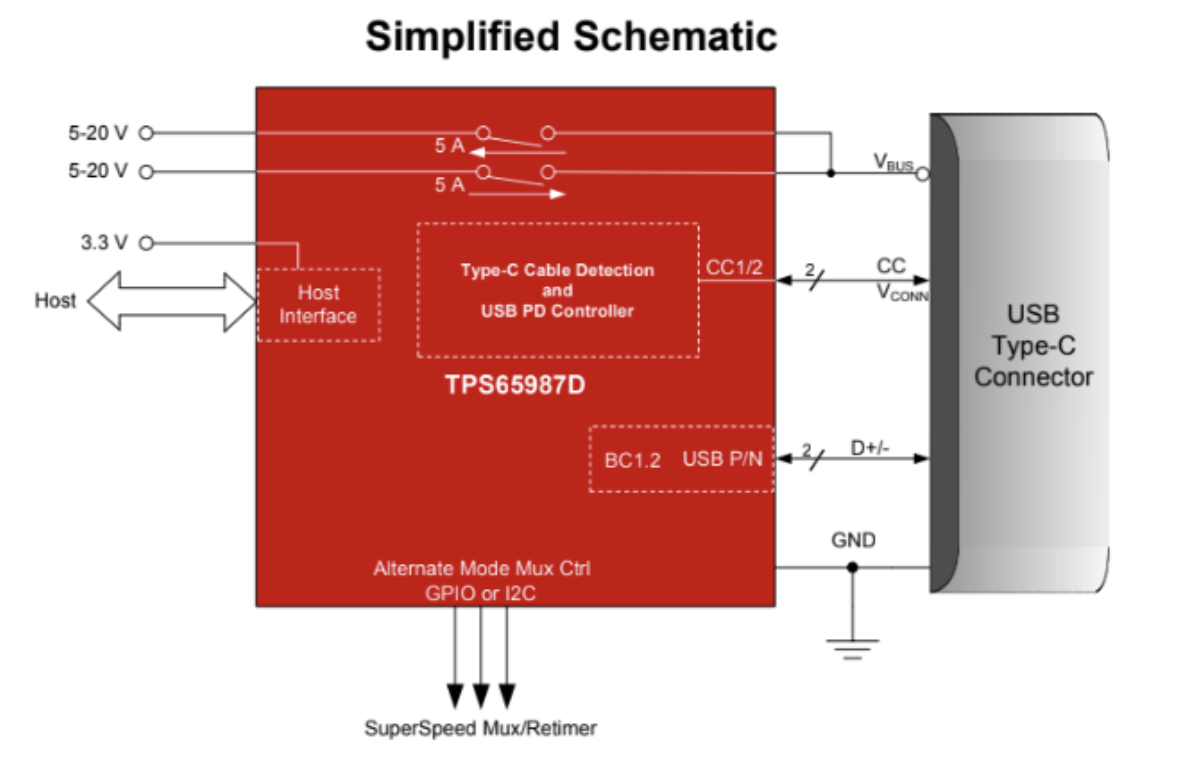 Found on page 1 of TPS65987D USB Type-C and USB PD Controller with Integrated Power Switches datasheet
Found on page 1 of TPS65987D USB Type-C and USB PD Controller with Integrated Power Switches datasheet
Microchip UPD360, USB Type-C Power Delivery Controller
This part supports USB-C within an integrated controller that allows dual role power in its power delivery function. The part integrates directly accessible registers for controlling the I2C and SPI features along with power management including a watchdog and resets. There are GPIOs for use within the system and given extra pins, the part is designed into a BGA footprint packaged into a 44-ball WFBGA.
The UPD360 is a highly integrated small form factor USB Type-C/PD controller compliant with USB Type-C™ specification and USB Power Delivery specification v.2.0. UPD360 provides cable detection and orientation, and implements baseband communication with a partner USB Type-C/PD device. UPD360 can function as a standalone charger or as a companion Power Delivery controller to an external MCU/SoC, using the integrated I2C/SPI interface.
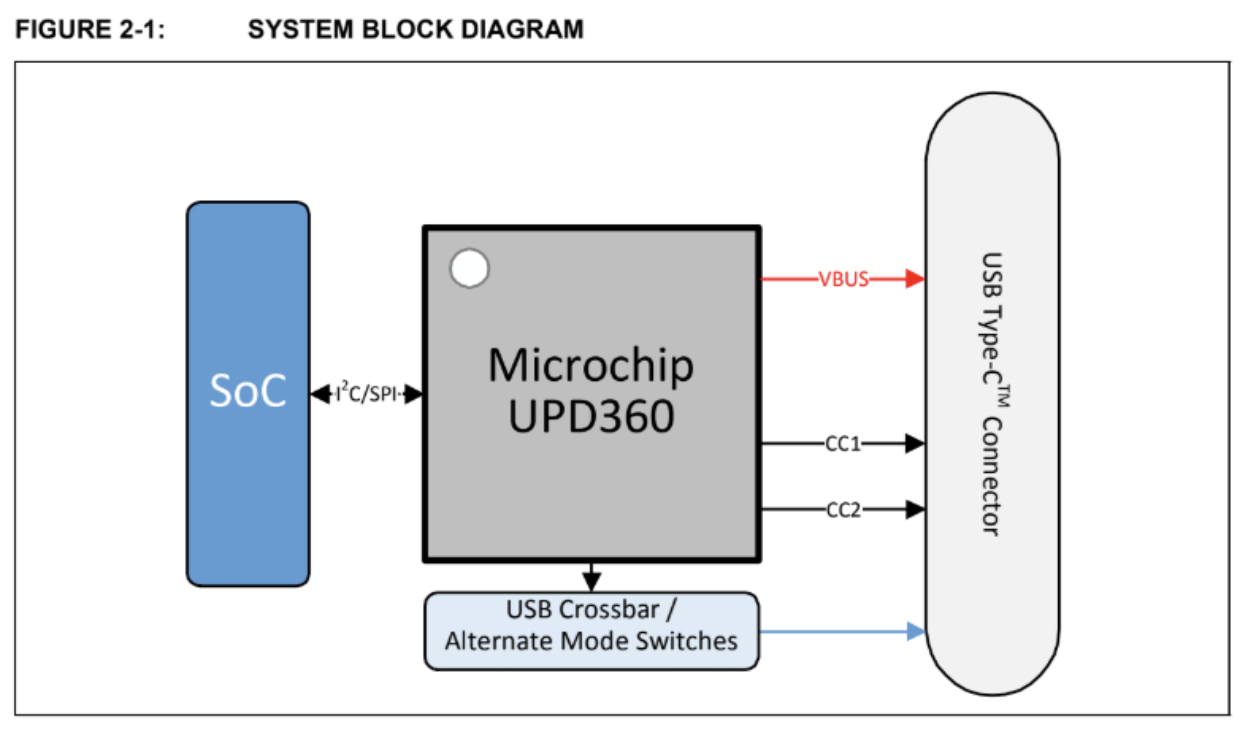 Found on page 7 of UPD360 Highly Integrated Small Form Factor USB Type-C™ Power Delivery 2.0 Port Controller datasheet
Found on page 7 of UPD360 Highly Integrated Small Form Factor USB Type-C™ Power Delivery 2.0 Port Controller datasheet
Cypress EZ-PD™ CCG6, USB Type-C Port Controller
This is a part with integrated processor for use as a USB-C controller. It has onboard memory and supports configuration of SuperSpeed and high-power of up to 100W. Supporting high power includes integrated USB charger blocks. Addressable registers support interface with I2C, SPI, and Thunderbolt with configurable modes. It is available in a 40-pin QFN package.
EZ-PD™ CCG6 is a one-port USB Type-C controller that complies with the latest USB Type-C and PD specifications. CCG6 provides a completed USB Type-C and USB-Power Delivery port control solution for PCs and notebooks. CCG6 includes a VBUS provider path load switch controller, a 32-bit, 48-MHz Arm® Cortex®-M0 processor with 128-KB flash integrates one complete Type-C Transceiver including the Type-C termination resistors Rp, RD, and RD-DB. CCG6 is available in a 40-pin QFN package.
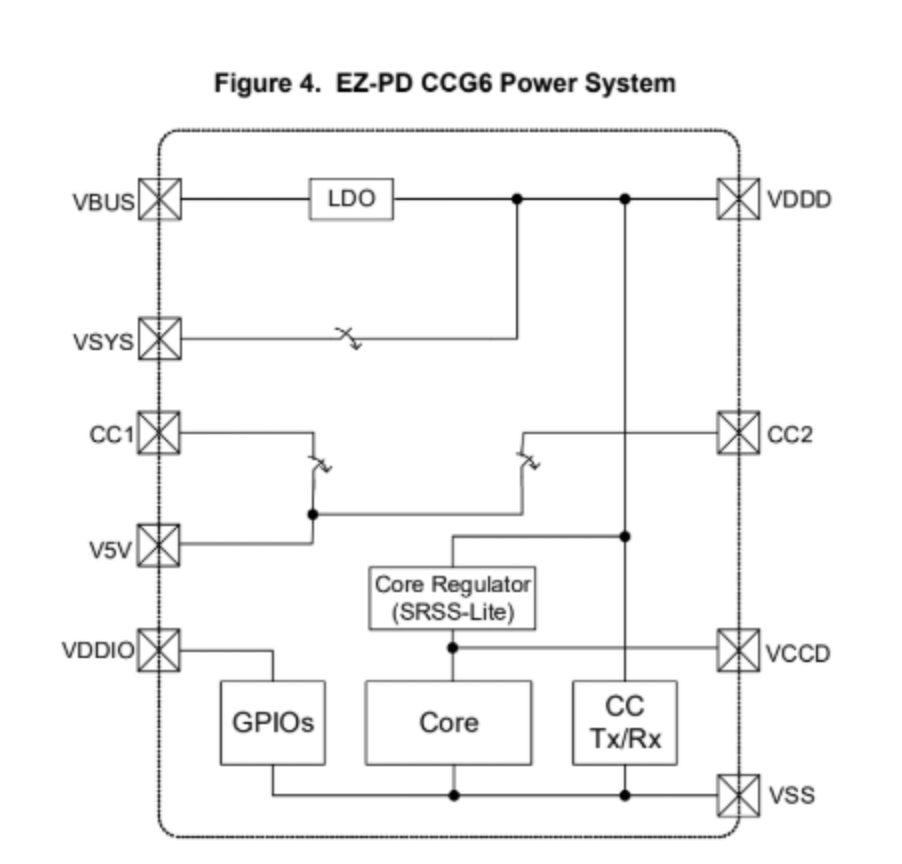 Found on page 8 of EZ-PD™ CCG6 USB Type-C Port Controller datasheet
Found on page 8 of EZ-PD™ CCG6 USB Type-C Port Controller datasheet
USB-C is the latest in a successful universal protocol adopted and used in many consumer USB devices. As transmission speeds increase with the need for more power at smaller form factors, USB-C will continue into the future as the protocol that delivers with USB cables that don’t break. Take a look at the components suggested above and check out similar parts on the detail pages.
Stay up-to-date with our latest articles by signing up for our newsletter.